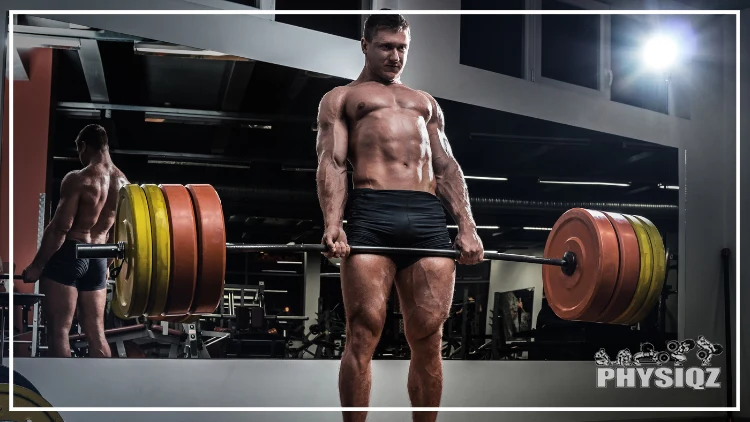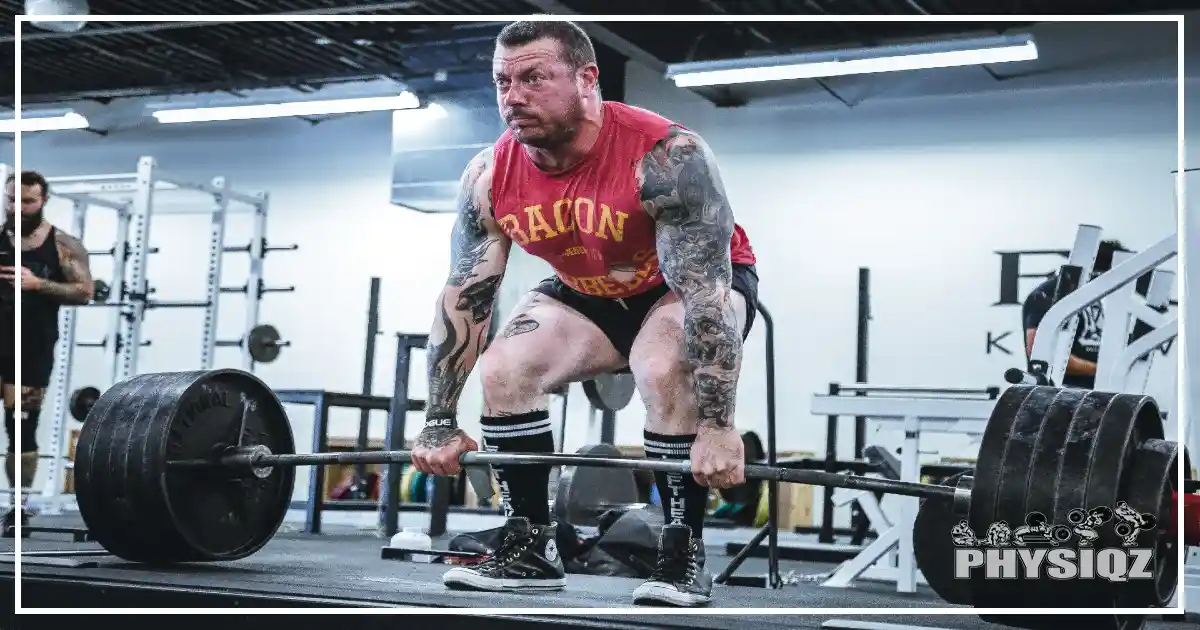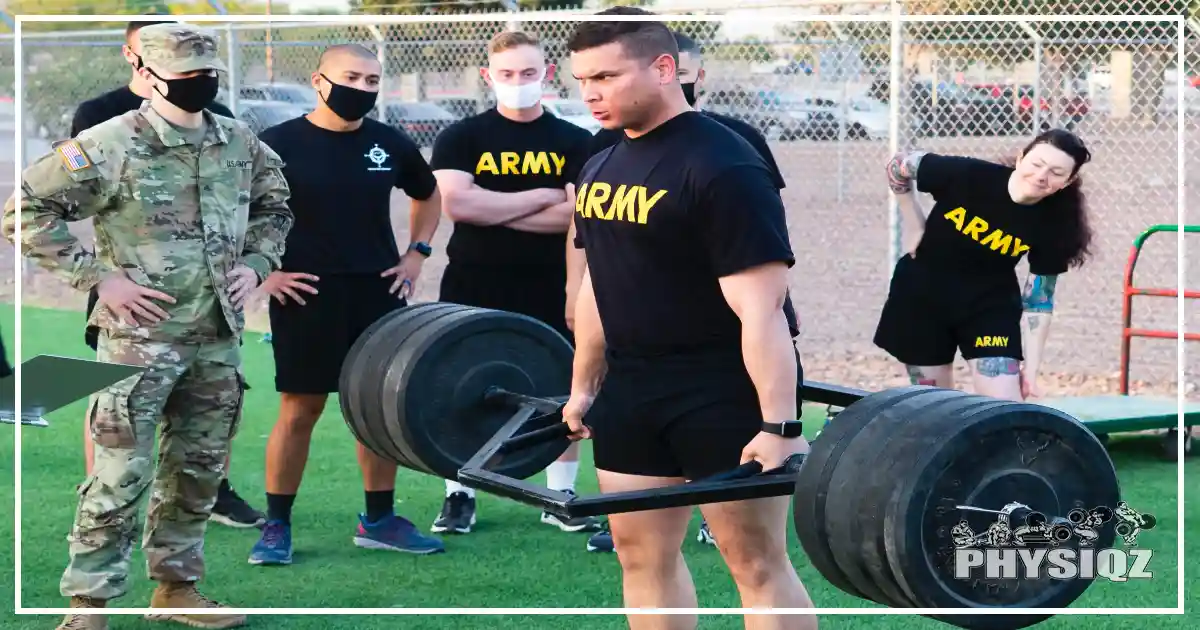
Many weightlifting beginners often inquire about where they should feel the impact of deadlifts, and naturally, opinions vary widely on the exact location of this sensation.1
However, most people are so focused on a particular muscle group and the best way to feel it in the right place is by building tension in the set up and sitting back to feel the tension where it should be – on the posterior chain. So use this trick in addition to recruiting the lats before the lift to build tension and reduce the chances of rounding when deadlifting because it works every time.
Deadlifts & the Posterior Chain
Deadlifts are one of the best full-body exercises in the world of fitness and are known as compound exercise because they involve multiple groups of muscles simultaneously.2 Notwithstanding, when you deadlift responsibly with good form, you should feel the deadlift in the muscles on the backside of the body – that is, the posterior chain.
As such, deadlifting should be a workout to work on the backside but not to cause injuries. And though deadlifts could cause some fatigue in the posterior chain, powerlifters experiencing back pain is an indication of lacking technical proficiency in the craft.
Thus, learning the proper deadlifting technique is of utmost importance for anyone who wants to achieve their powerlifting goals.
Understanding Deadlifts: Which Muscles Should You Feel Engaged?
Many newcomers to powerlifting often wonder which muscles, besides the posterior chain, should be felt during deadlifting. As stated above, a deadlift is a total body exercise that involves a variety of muscles in the upper and lower body.
Initiating a lift of the bar involves the activation of various body muscles to create and maintain the tension needed to pull the weight off the ground. And while doing so, the weightlifter will surely feel the deadlift in these muscles. However, feeling the muscles while deadlifting is entirely different from feeling sore in certain areas afterward – or rather Delayed Onset Muscle Soreness (DOMS).
Deadlifts, as a compound exercise, engage dozens of muscles throughout the body. When performed correctly, they activate the entire posterior chain, including the hamstrings, erector spinae, calves, lats, and glute muscles. Additionally, deadlifts also target the back muscles.
However, since so many muscles are being used at once, many times lifters may not feel deadlifts in any one area – unlike isolation exercises that focus on a specific muscle or muscle group.

Photo by Alora Griffiths on Unsplash3
Below are some of the main muscles a weightlifter feels while deadlifting and their role in the lift.
Glutes
Glutes are a group of muscles that are part of the posterior chain and lie at the back of the hip (butts). It includes three main muscles namely gluteus maximus, gluteus medius, and gluteus minimus, plus the deep six muscles.
Essentially, the gluteal muscles play a vital role in hip extension when performing deadlifts. And as the body moves into a standing position at the top of the deadlift, the glute muscles lock the hip out.
This lock-out phase occurs as the barbell comes into contact with the hip, and it prevents back rounding. As such, it is critical to squeeze the glutes at this point. When deadlifting with proper technique, the lifter should feel the deadlift in the glutes.
Hamstrings
The hamstrings are another group of muscles that a lifter feels when deadlifting. They are located at the back of the thigh. When executing a deadlift, the hamstrings have two key roles. First, they work in conjunction with the gluteal muscles lockout at the top of the lift, bringing the hip close to the barbell. Secondly, the hamstrings work together with the quadriceps as stabilizing forces in the knee joints. They help stabilize the legs and maintain an optimal path of the barbell.
Quadriceps
Quadriceps (quads) are the muscles in the front the of thigh extending from below the hip to above the knee. They activate during the bottom half of the range of motion, and their role is to propel knee extension. The lifter engages the quads and “pushes the ground away.” Doing so creates the tension needed to break the barbell off the ground. Thus, the lifter will most likely feel deadlifts in quads.
Erector Spinae
The Erector spine is the muscles located on either side of the spine. One of their key roles when performing a deadlift is to extend the back. Basically, erectors activate when pulling the bar to help move the back from the bent position to a straight one. Secondly, they help keep the back in a flat position during concentric and eccentric phases of the deadlift. Maintaining a straight back is essential since it prevents back injuries.
Latissimus Dorsi (Lats)
The lats are the wing-like muscles covering the middle and lower back. Their key role during deadlifting is to keep the barbell as close to the body as possible. Doing so prevents the barbell from drifting off the body and causing unprecedented injuries.
When the bar drifts off the body, it might be a sign that the lifter has weak lats. To feel the lats while deadlifting, the lifter should use this trick that works every time – imagine “crushing an orange” under the armpit. This is a surefire way to engage the lats and get the best out of the deadlift.
Of course, the exact point in the posterior chain will differ slightly from person to person depending on their strength, anthropometry, and mobility, among other factors. In simple terms, lifters can expect to feel the deadlift anywhere in the back region, such as in the glutes, hamstrings, or lower back.
Where Should You Feel Sore After Deadlifting?
Beginners taking powerlifting programs might feel soreness the following day or so after deadlifting. This is commonly referred to as Delayed Onset Muscle Soreness (DOMS). DOMS can occur anywhere in the upper or low back, glutes, traps, hands, and legs – and it’s normal.
The body is just responding to unaccustomed loads subjected to the muscles. A weightlifter can also feel soreness in the glutes if they train with more weight or change technique.4
But if there is low back pain and the lifter has been training all through, this is not normal. This is probably an injury on the back resulting from deadlifting with bad form and should be addressed with a healthcare professional.

Photo by Matthew Hintz on Pexels5
Should My Back Be Sore After Deadlifts?
When a beginner is just beginning weightlifting, it is common to have a sore back after deadlifts. Back soreness can happen after intense training of the upper body with high reps. Also, low back sores can occur when the beginner lifts heavy weights with high reps. However, the DOMS will definitely go away within a few days of repeated exposure to weights.
DOMS can also occur when experienced weightlifters subject their back muscles to repetitive eccentric and concentric movements or novel exercises.
However, if the lifter is not new to deadlifting and feels excessively sore in the low back after every deadlifting session, this is not normal DOMS. This is an indication of deadlifting with poor technique, and it can cause serious injuries to the lower back.6
Do Deadlifts Make Your Glutes & Hips Feel Sore?
The sensation of deadlifts is primarily felt in the posterior chain. Once you learn how to build tension across this entire muscle group, you may begin to notice soreness in various areas, such as your glutes and hips.
Deadlifts can make glutes and hips feel sore because of DOMS. Since DOMS is common, especially among beginners, the soreness is not something to worry about.
Glutes and hips can also feel sore after deadlifts because of fatigue that comes from the change of technique or using a deadlift variation that puts more tension on these muscles. According to research, the conventional deadlift recruits the glutes more than the Romanian variation.7
However, if the lifter is not a beginner and has not changed technique, persistent soreness in the glutes and hips may imply there is muscle injury. The injury arises from deadlifting with bad form and poor setup at the first lift.
Should My Hamstrings Be Fatigued After Deadlifting?
Hamstrings are primary movers in deadlifts and can get sore because of fatigue. They get fatigued when they are recruited to deadlift weight more than they are used to. It’s worth noting that this kind of fatigue can happen even when there is no injury or DOMS in the hamstrings. According to studies, muscle fatigue results from neuromuscular adaptations to resistance training.8 The only time to worry about sore hamstrings is when there is persistent soreness that may signal an injury.
What Other Muscles Might Be Sore From Deadlifts?
Deadlifts are a compound exercise that targets several major muscle groups in the body, including hamstrings, glutes, lats, quadriceps, and erector spinae. The movement during deadlifting requires significant involvement from the legs, hips, back, and shoulders as well as from those smaller muscle groups. As such, it’s no surprise that any of those muscle groups might feel sore after deadlifting.
Are Deadlifts Supposed To Be Painful?
No, deadlifts are not supposed to be painful. However, It’s not unusual for deadlifts to cause muscles to be sore when starting workout routines — as long as the lifter does them using proper form.
But for experienced weightlifters, persistent muscle pain after deadlifting is an indication of possible injury due to bad technique.
How Should My Lower Back Feel After Deadlifts?
When deadlifts are performed optimally with good form and proper technique, the lower back should feel just fine. And if anything else, a little soreness (DOMS) of the erector spinae a day or two after starting deadlifting or increasing weight load. Of course, the posterior chain muscles will respond to the weight, and feeling some soreness or little fatigue shouldn’t be a red flag.
What is not normal is consistently feeling sharp lower back pain after deadlifting, as it can be a serious injury.
Are Deadlifts for Back Day or Leg Day?
This is another issue that arises when attempting to determine where deadlifts should be felt. The debate on whether deadlifts are for the back day or leg day is common in the world of weight lifting. Professional weightlifters have different views on which day to perform deadlifts. Some advocate for the back day, while others insist deadlifting is for leg day.
Well, deadlifting primarily involves the extension of the knees and hips to activate the quads, hamstrings, and glutes. In this sense, deadlifting is primarily a leg exercise. But then, back muscles, including the lats and erector spinae, are also recruited during deadlifting.
Comparing Where You Feel Deadlifts & Which Muscle Groups They Target More
Since the knees and hips extension are the main movements when pulling the bar, deadlifts are more of a leg exercise. But depending on the goals, a lifter can deadlift on either leg or back day.
Better still, lifters can choose a specific day to perform deadlifts alone. Doing so can help the lifter get the best out of the deadlifts by building strength and achieving maximum hypertrophy.9 Also, some strength athletes have a dedicated day for deadlifting because it’s very taxing on the central nervous system.
Queues To Feel Deadlifts in the Posterior Chain
Weight lifters should feel deadlifts in the posterior chain if they train with the proper technique, the right weight, and optimal frequency. By doing so, they will reap the maximum benefits of their deadlift workout and avoid back pain and injuries.
Here are some top deadlift queues to help lifters feel deadlifts in the right place –the posterior chain:
- Keep the back straight: Maintaining a straight back during the entire lift is essential for good form. It’s important not only for avoiding spine injury but also because it helps keep your body in line so that all of your muscles are working together effectively during each rep. Lifters should activate the core muscles so that the back stays straight and sturdy.
- Engage the lats: Engaging the lats creates pre-pull tension across the back that is crucial in maintaining the stability of the spine and upper when lifting. Firing the lats prevents back rounding and pain. Thus, sustaining the engagement of the lats from the setup to the execution of the lift is a foolproof trick (it works every time) to feel deadlifts in the posterior chain.
- Keep the barbell closer to your body: Improper positioning of the barbell at the start of the deadlift is a bad form and a common cause of back pain. The best cue is to keep the bar over the midfoot and closer to the shines when starting. Having this setup will keep the bar in an optimal line of pull and prevents straining of the lower back.
- Bend the knees enough: Bending the knees enough puts the lifter in the correct position to “push the ground” and grab the bar without pressuring the waist. Failure to bend the knees enough will strain the low back and hamstring when lifting. The right body position should form a “wedge” – where the hips are above the knees and the chest above the hips. Mastering these 10 cues for deadlift setup perfection can help lifters achieve proper form.
- Don’t overextend at the top of the lift: Overextending your lower back during a deadlift is never a good idea because it can put added stress on the lower back and lead to spinal injury. Instead, focus on keeping your back straight and tight as you lower the barbell to the ground.
In general, the lifter should feel the engagement of the posterior chain of muscles when deadlifting with good form. And though DOMS may arise from deadlifts, weightlifters should be keen to know when it’s DOMS or injury.
Persistent pain in the lower back isn’t normal as it might signal serious injury to the back. The advantage of regularly performing deadlifts with the correct technique is that you can experience sensations in various muscles of the posterior chain, effectively addressing the question of where deadlifts should be felt.
References
1A’s Images. “Strong Man Doing Deadlift.” Canva. Accessed 6 April 2023 <https://www.canva.com/photos/MAE3Xq2atbA-strong-man-doing-deadlift/>
2Barnes, M. J., Miller, A., Reeve, D., & Stewart, R. (2019). Acute Neuromuscular and Endocrine Responses to Two Different Compound Exercises: Squat vs. Deadlift. Journal of strength and conditioning research, 33(9), 2381–2387. Retrieved July 24, 2022, from <https://doi.org/10.1519/JSC.0000000000002140>
3Griffiths, Alora. “black adjustable-weight barbell photo – Free Strong man Image on Unsplash.” Unsplash, 15 August 2018. Accessed 6 April 2023 <https://unsplash.com/photos/E3wehabi_B4>
4Whittal, M. C., Zwambag, D. P., Vanderheyden, L. W., McKie, G. L., Hazell, T. J., & Gregory, D. E. (2020, September 22). High Load With Lower Repetitions vs. Low Load With Higher Repetitions: The Impact on Asymmetry in Weight Distribution During Deadlifting. NCBI. Retrieved July 24, 2022, from <https://www.ncbi.nlm.nih.gov/pmc/articles/PMC7739658/>
5Hintz, Matthew. “A Man in Black Shirt Lifting Weights · Free Stock Photo.” Pexels, 10 October 2021. Accessed 6 April 2023 <https://www.pexels.com/photo/man-people-woman-vehicle-9845021/>
6Bengtsson, V., Berglund, L., & Aasa, U. (2018). Narrative review of injuries in powerlifting with special reference to their association to the squat, bench press and deadlift. BMJ open sport & exercise medicine, 4(1), e000382. Retrieved July 24, 2022, from <https://doi.org/10.1136/bmjsem-2018-000382>
7Lee, S., Schultz, J., Timgren, J., Staelgraeve, K., Miller, M., & Liu, Y. (2018, August 11). An electromyographic and kinetic comparison of conventional and Romanian deadlifts. PubMed. Retrieved July 24, 2022, from <https://pubmed.ncbi.nlm.nih.gov/30662500/>
8Vieira, J. G., Sardeli, A. V., Ricardo, M. D., Filho, J. E., Campos, Y., Sant’Ana, L., Leitão, L., Reis, V., Wilk, M., Novaes, J., & Vianna, J. (2021, December 9). Effects of Resistance Training to Muscle Failure on Acute Fatigue: A Systematic Review and Meta-Analysis. PubMed. Retrieved July 24, 2022, from <https://pubmed.ncbi.nlm.nih.gov/34881412/>
9Krzysztofik, M., Wilk, M., Wojdała, G., & Gołaś, A. (2019, December 4). Maximizing Muscle Hypertrophy: A Systematic Review of Advanced Resistance Training Techniques and Methods. NCBI. Retrieved July 24, 2022, from <https://www.ncbi.nlm.nih.gov/pmc/articles/PMC6950543/>